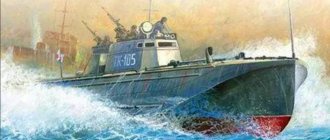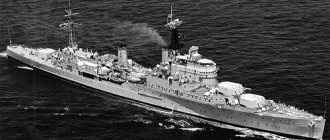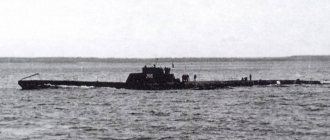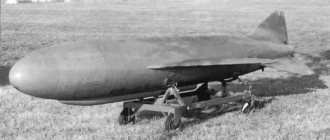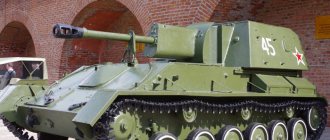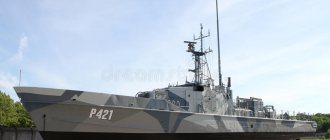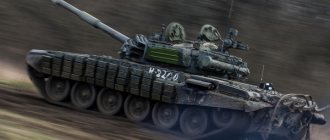The Soviet Union is rightfully considered the ancestor country of such a class of warships as missile boats. The naval concept for the development of the fleet, developed in the depths of the Supreme Naval Leadership, provided for equipping the fleet with small combat vessels, which in terms of weapon power were comparable to ships in the far sea zone. The creation of a “mosquito fleet” made it possible to create effective means of defense of sea borders in a short time and at fairly low costs. High speed, stealth and powerful missile weapons made such ships truly dangerous opponents for any warship.
The appearance of missile boats at sea negated the advantages of a large ocean-going fleet in the coastal sea zone. Subsequent historical events showed the correctness of the developed concept. The missile boats created by Soviet designers became a “revolutionary breakthrough” in the history of world military shipbuilding. Despite their small displacement, thanks to their high speed and powerful weapons, ships of this class were classified as corvettes in the Western classification. Missile boats of the Project 1241 type, which were built at domestic shipyards over the course of 17 years, are rightfully considered one of the best representatives of ships of this class.
Background to the appearance of Project 1241 boats
It should be noted that the idea of creating a “mosquito fleet” is not new. Even on the eve of the First World War, some European states sought to strengthen their own naval forces by building small, high-speed combat ships. At that time, the main armament of ships of this class was mine weapons. The successful use of torpedo boats by Italian sailors during a naval war with a stronger enemy showed the great capabilities of a small fleet. From the category of a fleet for the poor, the “mosquito fleet” has moved into the category of the most effective tools for conducting combat operations in the coastal sea zone.
After the end of World War II, the same idea began to be developed in the Soviet Union. While modern navies have learned to effectively combat torpedo and mine weapons, the advent of missiles has opened up new horizons for warfare at sea. Ships with a small displacement, high speed and armed with anti-ship missiles could become a reliable shield in the defense of ports and fleet bases. Particularly attractive was the opportunity to install combat missiles on a moving platform with a high speed.
The first sign was the Komar-class missile boat, which was actively built in Soviet shipyards for 3 years, from 1959 to 1961. In such a short period of time, up to 100 warships were launched, each of which carried two SS-N-2A Styx anti-ship cruise missiles.
It was these warships that were the first to demonstrate their effectiveness in practice. During the Six-Day Arab-Israeli War of 1967, an Egyptian Komar-class missile boat managed to sink the Israeli destroyer Eilat. This was the reason for the intensive and massive construction of ships of this class all over the world. Third world countries, which could not afford to build or maintain large navies, paid special attention to new weapons.
The Soviet Union was considered the clear favorite in this arms race. By that time, the USSR Navy already had a fairly large number of missile boats of various types in service. New, more powerful vessels were being developed, capable of performing a wider range of tactical tasks. The pinnacle of design thought was Project 1241, a new Tarantula-class missile boat.
Mine boats
Torpedo boats are fast, small-sized and fast vessels, whose main armament is self-propelled combat projectiles - torpedoes.
The ancestors of boats with torpedoes on board were the Russian mine ships “Chesma” and “Sinop”. Combat experience in military conflicts from 1878 to 1905 revealed a number of shortcomings. The desire to correct the disadvantages of boats led to two directions in the development of ships:
- Dimensions and displacement have been increased. This was done in order to equip the boats with more powerful torpedoes, strengthen artillery, and increase seaworthiness.
- The ships were small-sized, their design was lighter, so maneuverability and speed became an advantage and the main characteristics.
The first direction gave birth to such types of ships as destroyers. The second direction led to the appearance of the first torpedo boats.
Boats
Varieties
torpedo boat
Patrol boat
Raid boat
Hovercraft
Missile boat - small missile ship
Landing craft
Torpedo boat type g-5
Gunboat
Patrol boat
Mine boat “Chamsa”
The birth of the new Project 1241 missile boat
The combat use of missile boats clearly showed how effective this type of naval weapons can be. Missile weapons, which over time became the main type of weapons in the navy, radically changed the tactics of naval combat. In modern combat conditions, direct contact between the warring parties has lost its meaning. Strikes could be delivered not only unexpectedly and over long distances, but also with much smaller forces. A large warship became vulnerable at sea to the weakest enemy. Almost missile boats evened out the chances of the navies, shaking the principles of mastering the naval theater through large formations of warships.
The Project 1241 missile boat is the most modern type of ship of this class, which continues to remain in combat service in the Russian Navy. Despite the fact that the first ship was launched in 1978, more than 40 years ago, the effectiveness of this type of naval weapons still remains at a high level. Representatives of the US Navy, who were able to test the tactical and technical characteristics of the ship in practice, spoke flatteringly about the high combat capabilities of the Soviet ship.
Note: The Tarantula-class boat "Rudolf Egelhofer", part of the East German Navy, became part of the German Navy after the unification of the country. The ship received a new name and was soon transferred to overseas allies for careful study.
The lead ship of this project was launched in Leningrad in 1978. The place where the boat was built was the shipyard named after. Petrovsky, now the Primorsky Shipyard. The new large missile boat received the code “Tarantula” and was classified in Western countries as a corvette.
The design documentation for the warship was developed by the designers of the Central Marine Design Bureau "Almaz" - the patrimony of Soviet missile boats and ships of other main classes. Initially, the technical assignment for the creation of a more advanced ship was received back in 1973. The design documentation for a new missile boat with four anti-ship missiles was ready within 2 years, but the implementation of the project had to be postponed for a while. The delay in the construction of the ships was due to ongoing work on the creation of a new anti-ship complex "Mosquito", which was planned to arm new ships.
The new ship was supposed to have a larger displacement, better seaworthiness and increased autonomy compared to previous ships of this class. The 3M80 anti-ship missiles in service with the Navy had significant dimensions and weight, so it was necessary to create a highly mobile platform with a larger displacement. The target was 400-500 tons, which were supposed to accommodate a new powerful propulsion system, more advanced radar equipment and four 3M80 anti-ship missiles.
It was planned to equip the Black Sea and Baltic fleets with new small ships, which needed to have a reliable and powerful strike force in a limited naval theater. At the same time, an export version was also developed. The main customers for the new ship were Arab countries, the Navy of Vietnam, Cuba and countries belonging to the Warsaw Pact organization.
The purpose of Project 1241 ships is to launch a missile strike against potential enemy ships in the near sea zone. Thanks to their high speed, missile boats could quickly intercept an enemy ship, launch combat missiles, and escape at high speed from a retaliatory strike.
Following the lead ship, serial construction of ships began. For the needs of the Soviet Navy, 13 boats of this project were built. 20 ships of this type were exported. In the Vietnamese Navy, Soviet missile boats constituted the main striking power of the fleet. The Tarantula missile boats joined the ranks of the navies of the Warsaw Pact countries, the Egyptian Navy, the Navy of Yemen, India and Turkmenistan. In total, up to 80 missile boats of all modifications were launched, the basic basis for which was Project 1241.
Military hydrofoil boat
At the end of the 19th century, the first attempts to build hydrofoil ships began. The first country that decided to develop the speed of water transport is France. It was there that de Lambert, a designer of Russian origin, proposed creating a ship with wings under water. He suggested that when using hydrofoils or propellers, some kind of air cushion would be created under the ship. Due to it, water resistance will be much less and ships equipped with hydrofoils will be able to reach much higher speeds. But the project was not implemented, since the power of steam engines was simply not enough.
History of the development of hydrofoil boats
At the beginning of the last century, the Italian aircraft designer E. Forlanini was nevertheless able to realize Laber’s idea of hydrofoils. And this happened thanks to the emergence and use of new, powerful gasoline engines. Multi-tiered wings and 75 hp motor. With. on gasoline, did their job, the ship was able not only to stand on its wings, but also reached a record speed of 39 knots at that time.
A little later, the American inventor improved the design, increasing the ship's speed to a record 70 knots. Later, already in 1930, an engineer from Germany invented wings of a more ergonomic shape, reminiscent of the Latin letter V. The new wing shape allowed the ship to stay on the water, even in strong waves, with a speed of up to 40 knots.
Russia also became one of the countries that were engaged in similar developments and in 1957, a famous Soviet shipbuilder developed a series of large boats codenamed:
- Rocket;
- Meteor;
- Comet.
The ships were very popular in the foreign market, they were purchased by countries such as the USA, Great Britain, as well as countries of the Middle East. Widespread use of hydrofoil boats served for military purposes, for reconnaissance of territory and patrolling maritime borders.
Features of Project 1241 boats
Both projects, domestic and export, provided ample opportunities for subsequent improvement of ships as part of the ongoing re-equipment and re-equipment. The boats were supposed to have a displacement of no more than 500 tons and carry powerful offensive and defensive weapons. The main combat weapons for the boats were the P-270 Mosquito anti-ship missiles, which were placed in two containers, two on each side. The missile containers were not homing, but were installed stationary with a constant elevation angle and at an angle in the center plane relative to the axis of the vessel.
The ship's anti-aircraft armament was represented by the Osa-M or Strela-3 air defense systems. Additionally, the ship's crew was equipped with Igla MANPADS. The traditional offensive and defensive weapon was the AU-176 artillery mount with a caliber of 76 mm, which could fire both at sea targets and at ground and air targets. The combat power of the boat was also enhanced by the 30-mm AK-630M artillery mount mounted on the stern.
The artillery mount has a total weight of up to 9 tons. The gun could fire automatically at a range of 4000 m.
Combat control and weapon guidance at the target was carried out by the Zhemchug multifunctional radar station. The operation of the system was semi-automated, which allowed the crew to take direct part in controlling the combat capabilities of the vessel. Despite the fact that the new radar had unique characteristics, its creation was delayed and therefore the boats launched were equipped with the Monolit radar.
A distinctive feature of missile boats is a cylindrical hood located above the wheelhouse. It houses the antenna of the active channel of the radar complex. The following series of boats began to be equipped with installations for launching decoys and projectiles with radar reflectors. These activities were carried out as part of electronic warfare, which has become intense at sea in recent years. PK-16 installations were located on the sides of the ship and could fire projectiles equipped with dipole reflectors.
Graviy-M radar stations were installed on export-built boats. In this regard, the Osa-M air defense systems were removed from the boats, and an additional AK-630M gun mount was installed.
The performance characteristics of the new Soviet missile boats were impressive. In its combat and fire characteristics, the Tarantula was more like a corvette. The boat could reach speeds of up to 36 knots on a combat course, and its economical cruising range was almost 1,500 miles. On later versions, which are currently in service with the Russian fleet, the cruising range is more than 2,000 nautical miles.
However, design data is one thing, and the real picture is another. As in the case of the Zhemchug radar, the development and commercialization of the Moskit anti-ship missile system was greatly delayed. It was decided to install proven P-15 Termit anti-ship missiles on the boats, and P-20 anti-ship missiles on ships under export contracts.
Note: The Soviet P-15M Termit missile had a launch mass of 2.5 tons and was equipped with a warhead weighing up to 400 kg; the missile flew at an altitude of 20-50 m at sea level, developing a speed of 320 m/s.
The power plant on the boats of both versions was represented by four M-75 main engines with a total power of 10,000 hp. and two M-70 engines, ensuring the ship moves at high speeds. The power of the afterburning engines was 24,000 hp. Despite the enormous power and high efficiency, the propulsion system on Project 1241 missile boats had a number of disadvantages. During mooring evolutions and at low speeds, the control of the propulsion system caused complaints from sailors.
Finally, it should be noted the good seaworthiness that the new ships possessed. The steel hull of the boat, divided into 9 waterproof compartments, has a saddle configuration and swift contours. With a hull length of 56 meters, the midship height of the boat was 5.31 m, which made the small ship resistant to sea conditions of 7-8. The vessel's superstructures are made of lightweight metal alloys, which significantly affected compliance with displacement restrictions.
In such conditions, the ship's crew consisted of 41 people, and the vessel's navigation autonomy was 10 days.
History of the construction of Project 1241 boats
Primorsky Shipyard, home to the Almaz Central Maritime Design Bureau, was chosen as the lead enterprise for the construction of Project 1241 missile boats. All boats of the first two modifications were built on the stocks of this shipyard. Subsequently, the construction of project boats of other modifications was carried out at three shipyards at once, at two factories in Leningrad and at one factory in the Khabarovsk Territory.
Project 1241 became the most widespread for ships of this class. Over 12 years, 41 ships of various modifications were built for the USSR Navy. By the time of the collapse of the Soviet Union in 1991, there were 6 more missile boats of this type on the stocks, the readiness of which was assessed differently, from 30 to 90%. The last ship of this project should be launched in 1996.
In the latest versions, a number of adjustments have been made regarding the ship's armament. Instead of 30-mm weapons, the boats were equipped with the Kortik anti-aircraft missile system. The boats also received a Positive target detection radar.
It should be noted that the export option was carried out by shipbuilding plants in Rybinsk and Yaroslavl. Under foreign contracts, 14 Tarantula-class missile boats were built for the navies of the Warsaw Pact countries. The largest orders were made by the GDR and Poland, which respectively purchased 5 and 4 ships. India has ordered four vessels for its Navy. One boat each was built for the Yemeni and Vietnamese navies. One missile boat of the export project was transferred to the Baltic Fleet training center located in Riga. The ship was used as a training platform to train foreign crews.
The increased interest in ships of this project from India is confirmed by the purchase of a license for the subsequent construction of ships of this class at shipyards in Mumbai and Goa.
For reference: In the navies of Romania, Poland, and India in the Ukrainian Navy, Project 1241 boats are classified as corvettes.
In the domestic Russian fleet today, 5 vessels of the very first project remain in service. The R-71 Shuya missile boat remains in service on the Black Sea. The Baltic Fleet includes the ships R-129 Kuznetsk and R-257. Until recently, the R-101 missile boat was transferred from the Northern Fleet to the Caspian Sea, where it became part of the Caspian military flotilla. One missile boat U155 Pridneprovye is part of the Ukrainian Navy.
Ships of later series and improved modifications continue to remain in service, representing the strike element of the Pacific Fleet, operating as part of strike formations of missile cruisers in the Black Sea and Baltic fleets. The largest detachment (10 combat units) of missile ships of this class is located in the Far East. Five ships were each in the Black Sea maritime theater and in the Baltic. One R-160 missile boat from the Black Sea Fleet was transferred to the Caspian Military Flotilla.
Needless to say, what role did Project 1241 missile boats play, serving for many years in the USSR Navy and the modern Russian navy. The construction of one ship of this class was simply incomparable in cost and expense with the construction of large ocean-going ships armed with missile weapons. Thanks to missile boats, first the Soviet and then the Russian fleet managed to create a combat-ready group of attack ships on their flanks.
